Previously on You’ve Got Mail, we looked at a few services that were designed to speed up the mail at various points along the way. But these improvements were all taking place on the USPS’ side of the the fence. Was there anything the customer could be doing to help out?
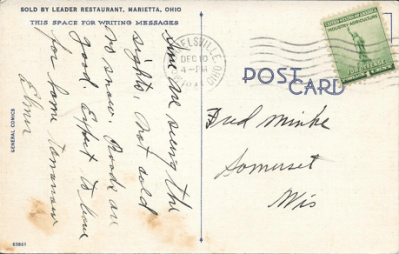
As it turns out, yes. And it was almost too late. Whereas you could once address a letter or postcard simply to “Fred Minke, Somerset, Wis.” and it would reach him, the volume of mail was getting completely out of hand with the rise of computers, automated billing, and advertising. Something was needed to improve routing and speed up delivery.
We all know enough about ZIP codes to use them, but where did they come from? How many types are out there? What do they even mean? Let’s find out.
Mountains of Mail
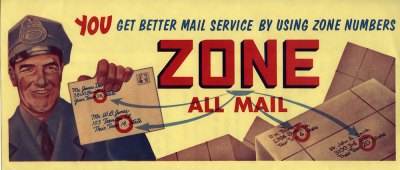
Between 1940 and 1960, the volume of mail handled each year went from 27.7 billion to 63.7 billion pieces. Blame the rise of the computer, because it brought about automated billing and invited return payment by mail. It also facilitated credit card transactions via mail. On top of that, the volume of junk mail and magazines was on the rise.
Another problem was that thousands of experienced postal workers left to serve in World War II, leaving behind those who weren’t so familiar with the address and city/state schemes. So in 1943, the post office came up with zone codes that would be used in 124 large cities to help sort the mail faster. Zones were identified on mail by the use of one or two digits between the city and state, for example, Birmingham 7, Alabama. Eventually, zone codes spread to 131 cities total.
Your Mail, Zipping Across the Nation
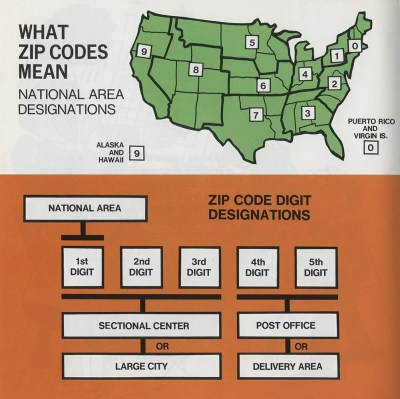
By the early 1960s, a more organized and robust system was needed. On July 1, 1963, the USPS introduced the non-mandatory ZIP code to the United States. ZIP stands for Zone Improvement Plan, and the implication is that the use of ZIP codes makes your mail zip along quickly. There were 41,702 ZIP codes in the United States as of October 2019.
And how does the ZIP code system work, exactly? Let’s break it down. The first three digits correspond to a Sectional Center Facility (SCF), which is a centrally-located facility for processing mail. The fourth and fifth digits narrow things down to a more precise location. In larger cities, the last two digits are generally carried over from the zone code days.
Although Robert Moon originally thought of and proposed the ZIP code in 1944, he only brought the first three digits to the table. The latter two are credited to Henry Bentley Hahn, Sr.
There are four types of ZIP code:
- Unique: these are assigned to a single, high-volume address like the CIA, NYU, or the Walmart HQ.
- Post office box-only: for example, 22313 is only for PO boxes at the main office in Alexandria, Virginia.
- Military: these are used strictly for Army Post Office/Fleet Post Office (APO/FPO) addresses overseas.
- Standard: this encompasses all other ZIP codes.
A Little Bit More: ZIP+4
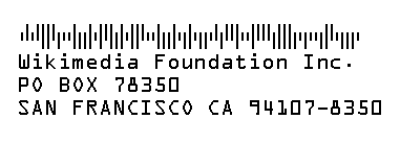
In 1983, the post office introduced the ZIP+4 scheme. This uses the standard ZIP code plus a four-digit code that targets the precise location.
The +4 generally indicates a city block, an apartment building or buildings, a specific post office box, or any other entity that generates a high enough volume of mail to warrant their own zip code.
Don’t bother adding the +4 today, as it is obsolete and will do nothing to speed up delivery times. Nowadays, addresses are read by a multi-line OCR that manages to determine the ZIP code from the address almost instantly, along with a more specific two-digit delivery point. Once this happens, it prints an Intelligent Mail barcode along the bottom.
Mr. ZIP
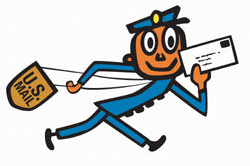
It was relatively easy to get businesses to use ZIP codes, because the USPS soon attached their use to lower mass mailing rates. But getting an entire country’s population to adopt a new practice was a different story. In order to help, the post office came up with a mascot named Mr. ZIP (or as his friends called him, Zippy) to encourage people to use ZIP codes.
Mr. ZIP’s origin is only semi-postal. He was based on a design created by Howard Wilcox, who worked for an ad agency and was the son of a letter carrier. Wilcox had designed the sketch of a cartoonish postman for use by a bank in a bank-by-mail program. AT&T got a hold of it somehow, and let the USPS use it for free.
Do yourself a favor and check out the ZIP Code Song performed by the Swingin’ Six below. If you really want to be entertained, spend fifteen minutes with them learning all about ZIP codes.
But Wait, There’s a Little Bit More
Stay tuned for that bit of trivia I’ve been promising since the beginning!

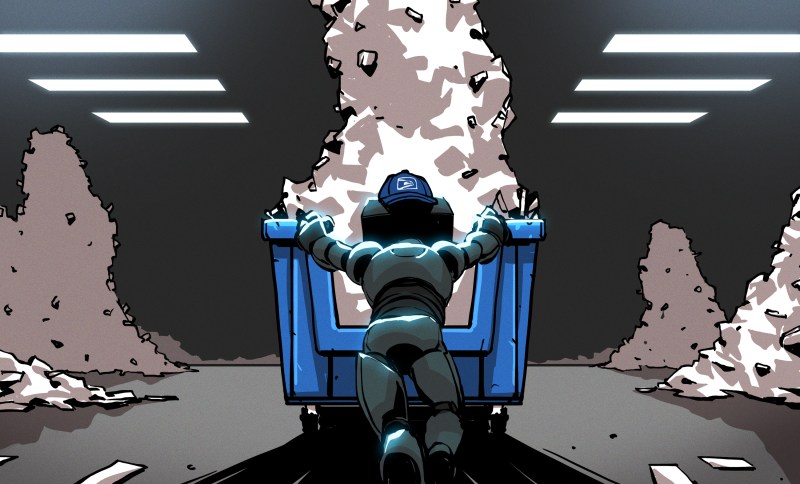















Did old people complain about how zip codes were evil or something when it was new?
Different era. People used to trust government . Shocking but true.
Fake news weren’t really a thing back then.
Oh please
William Randolph Hearst
Wikipedia says:
Modern postal codes were first introduced in the Ukrainian Soviet Socialist Republic in December 1932,[4] but the system was abandoned in 1939. The next country to introduce postal codes was Germany in 1941,[5] followed by Singapore in 1950,[6] Argentina in 1958, the United States in 1963[7] and Switzerland in 1964.[8] The United Kingdom began introducing its current system in Norwich in 1959, but they were not used nationwide until 1974.[9]
In my area, the change in address occurred due to 911 services requiring actual street names. My grandparents had lived on a side road off a numbered Route, but that wasn’t good enough for 911 dispatchers. So the roads and alleys got named for whichever resident had lived there longest; them in this particular case.
and the reply went to the wrong post
“Don’t bother adding the +4 today, as it is obsolete and will do nothing to speed up delivery times.”
A bit of knowledge I no longer need. It’s also interesting when the Post Office changed our addresses several decades back. Same mailbox, different address (might be from PO to some five digit number). Plus depending upon what government agency has it we can have two different towns.
In my area, the change in address occurred due to 911 services requiring actual street names. My grandparents had lived on a side road off a numbered Route, but that wasn’t good enough for 911 dispatchers. So the roads and alleys got named for whichever resident had lived there longest; them in this particular case.
About 15 years ago I worked with GIS apps to map and compare zipcodes to areacodes, exchanges, and state and county boundaries in the USA. This won’t work today with all the porting of phone numbers. It’s interesting how many zipcodes cover multiple counties, villages, towns, some places with low population perhaps even states. Take the zipcode 10940 for Middletown, NY. It not only covers Middletown in Orange County New York but surrounding towns and a small chunk of Sullivan County, NY. The zipcode for the Town of Newburgh also covers a section of Ulster County, NY.
Now explain the Canadian system!
The only postal code system that has a code for a mythical person (H0H 0H0).
Something. Learned. Every. Day!
There is some extra logic here. Check it out:
The first letter in a Canadian Postal Code is the major region. They go in alphabetical order from east to west. Thus ‘H’ is Montreal Island, ‘M’ is Toronto, and so on.
The next digit tells you whether a region is rural (zero). Thus the CBC in Toronto is at M5W 1E6, the ‘5’ being greater than one.
But wait… Montreal has no rural turf. How does “H0” work? If you give a zero to a metro region, you’re addressing its central post office — an internal address.
When they introduced the Postal Code in the late 1970s, Montreal was still the most populous city in Canada. It’s also bilingual. Thus the central Montreal office gets all the mail for Santa Claus, Saint Nick, Father Christmas… and Pere Noel.
Another fun fact: if you’re Canadian and an American gas pump wants your zip code, simply use 00 followed by only the numbers from your postal code. Santa’s credit card entry would therefore be 00000.
New zip codes are still assigned even today and old zip code can be revoked.
17927 used to be for Centralia, PA but it was retired due to dwindling population, less than 20 at the time. Centralia became ghost town due to coal fire underground that got started more than 50 years ago. (be sure to Google for Centralia PA coal fire for more on this)
85288 was newly added to a place in Arizona a year ago.
“Don’t bother adding the +4 today, as it is obsolete and will do nothing to speed up delivery times.”
Can you name your sources of information? according to USPS Postal Addressing Standards, this is not true,both business and residential use 5+4 zip codes (2023)
Standard : https://pe.usps.com/text/pub28/28c2_001.htm#ep526236
Business : https://pe.usps.com/text/pub28/28c3_009.htm
I think the point is just because it is in use doesn’t mean it will make your mail go any faster. The +4 isn’t mandatory. If I rad the article correctly every address is scanned automatically and near-instantly so there isn’t much need to add the +4, it’s redundant. My read anyway.
The thing is the OCR scans to find a match with the Postal Service National database and ZIP+4 is part of the database. so I wouldn’t skip the last part of the zip code. About making your parcel going faster, avoid handwriting in your address, use at least size 10 for printed fonts ,USPS recommends plain simple Windows fonts like Arial, leave a border space around your address(I think is at least 1/8 inch), avoid using dots and commas, uppercase is recommended, add two spaces between state and zip code, all this is to make life easy to the machine to read, if the OCR cannot read it ,it will be handled manually and… yes…it will take longer to arrive. I don’t have a link to this guidelines right now, but pretty sure a google search will show it. I have more than 13 years following those guidelines and I just got a few of those infamous yellow nixie labels: Unable to forward :)
“She wrote upon it,
Return to Sender, address unknown,
no such number, no such Zone!”
-Elvis
regarding the “Intelligent Mail barcode” Australia uses a barcode that looks identical but the payload (referred to as “Delivery point ZIP code” for the USA) is used differently. wikipedia says the USA uses “The full eleven-digit form includes the standard five-digit ZIP code, the ZIP + 4 code, and a two-digit code indicating the exact delivery point. “.
by contrast here the exact delivery point, (street address) is looked up in a database and confirmed as real, it is then assigned a unique number (one has no way of knowing if AusPost ever changes this number or alters the database, furthermore an address neighbouring your own, will have an unrelated unique number.
now i can find out my unique number, but Auspost dont make this information available, i can then use a free app to convert this number into the barcode. i wish to give this barcode to vendors who will be sending me stuff but it seems all systems of address input dont have the ability to attach a picture. the vendor is most likely NOT going to be able to create and print the barcode from my given address because the Auspost information is behind an expensive and PROPRIETARY system, making it only available to larger australian companies and a non starter for overseas (to me) vendors.
the point is my mail goes missing even with the barcode because Auspost is (admittedly rarely) putting the wrong barcode on the item. my address is mixed up with 2 other places that i know of. the state is always correct, the city is always correct, the type of written post codes we have cover a wide city area, the house number is correct, and the first 5 letters of the street are correct.
but when it fails, the rest of the street name is different or the street type is different or the suburb/locality is different. the ocr is reading 100% of the volume of the mail (but it doesnt recognise the street type or locality). the barcodes are applied by Auspost. the deliveries are 99.999% “on time” but the address is sometimes wrong and i dont think Auspost even know this and even if they did they dont want to spend the money to fix this invisible problem.
if they would just let us have our unique delivery point number to write in the address space, we could guarantee that if we put the correct number it would get the correct barcode.
I join the complaint against AusPost :) They don’t show online tracking info for international registered mail going to Australian territory, UPU tracking numbers like RM123456789XX ,at least not for my country :(
Is +4 really gone? I see it everywhere, and amuse it myself…
I don’t know the details, but my parents +4 is the same as my pobox +4 but they are miles apart
I always assumed the plus 4 was invented for high density areas like apartment blocks in NYC
The zone code also applies loosely to the first part of Social Security numbers. You SSN’s first three digits indicate what state you were in when you applied for your SSN, which is now where you were born since they require application at birth. I was born in Pennsylvania but got my SS card after the family moved to Maryland so my number starts with 21 but my parents started with 19.
MIne starts with NM……